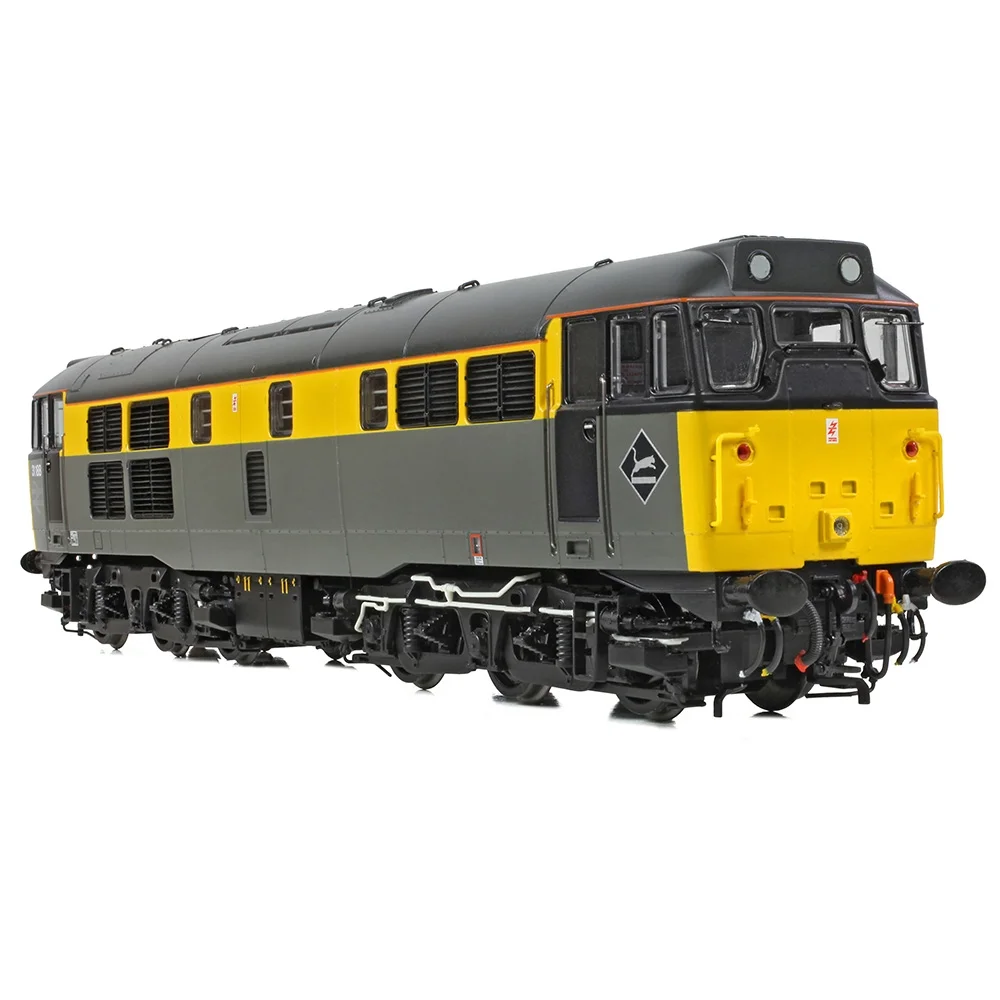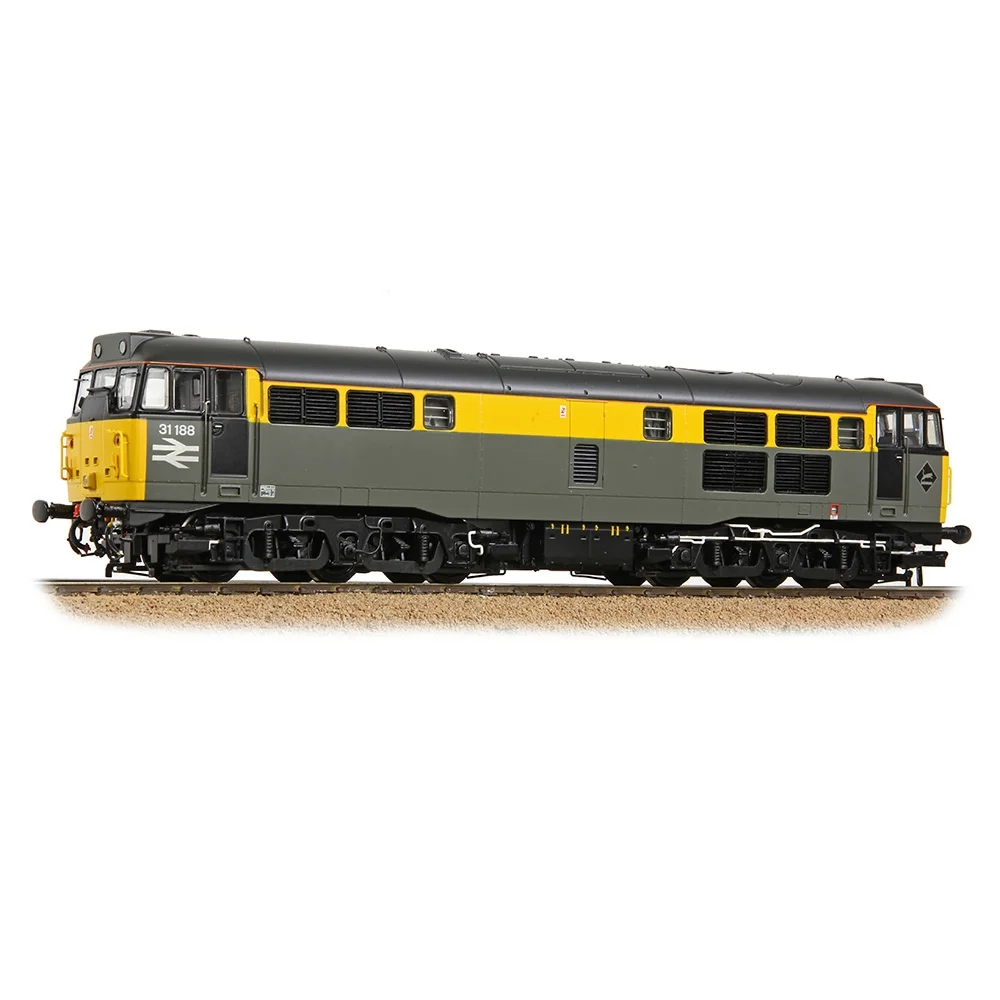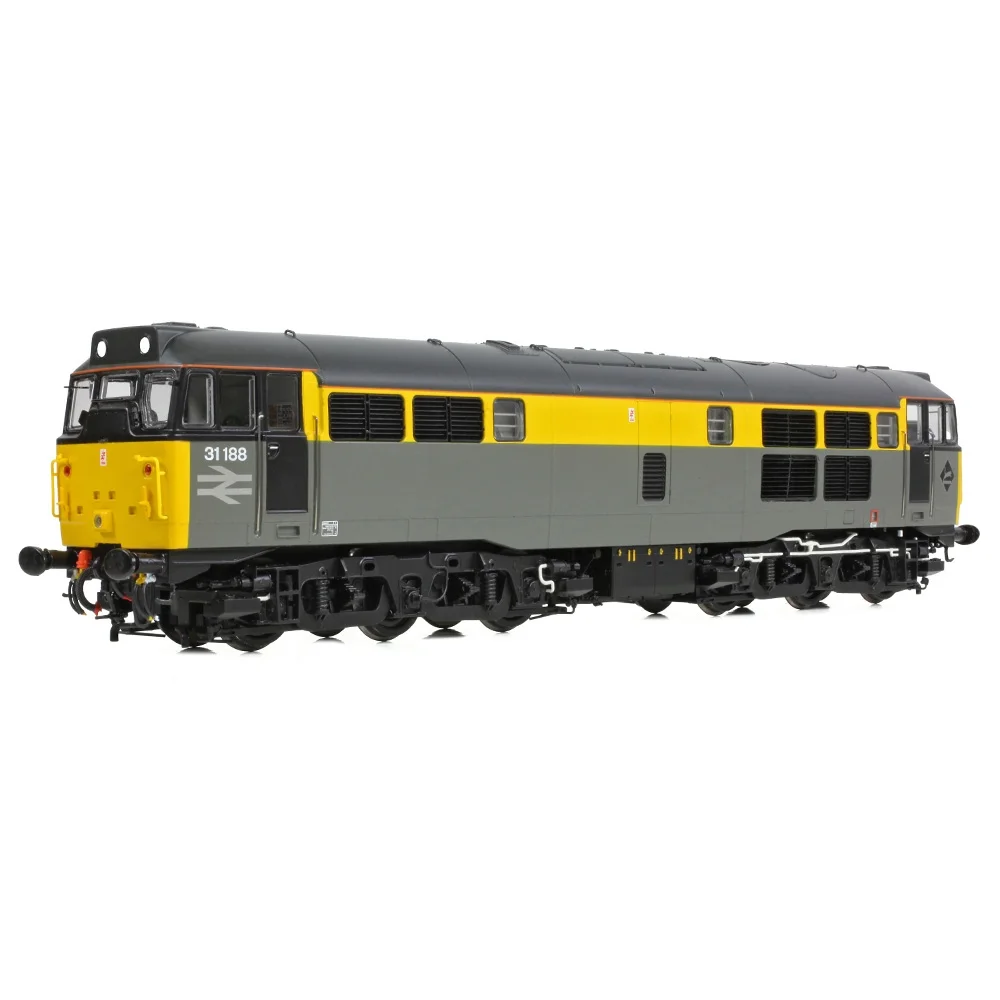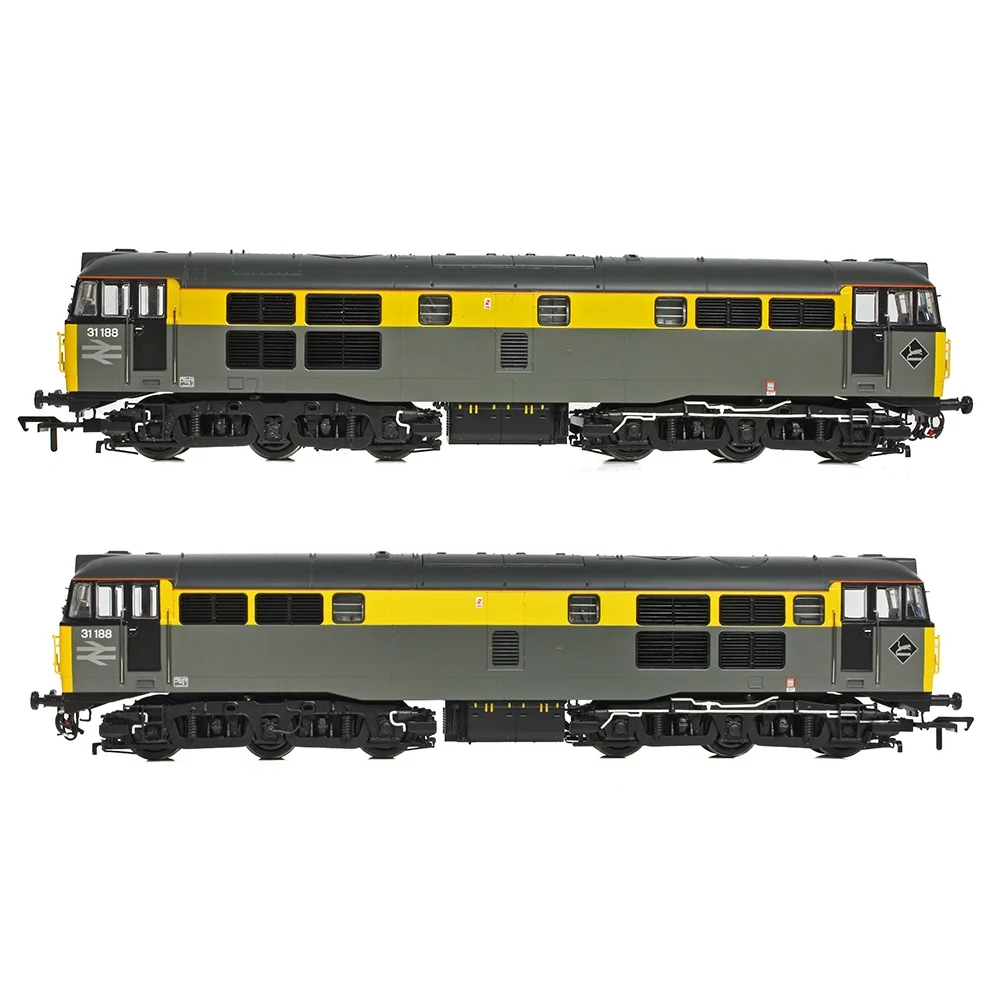Bachmann 35-822SF
British Rail Class 31/1 31188 British Rail Engineers Grey & Yellow
Bachmann's Description & Specifications
The Brush Type Twos – Class 30s and Class 31s – by Bachmann Branchline are back and better than ever, now featuring a Bach-Up Stay Alive System fitted as standard and all-wheel electrical pickup assuring the smooth and powerful performance you’ve come to expect from Bachmann Branchline models.
With high fidelity mouldings, numerous separately fitted parts and countless tooling variations to capture the minutiae of the real locomotives throughout their lives, our new Class 30 is brought to life with an exquisite livery application using true-to-prototype colours, fonts and logos. Along with an unprecedented array of lighting features, our Dual Fitted speaker system is fitted to all models – bringing to life our SOUND FITTED models. For the ultimate experience, choose one of our SOUND FITTED DELUXE models with their motorised radiator fan, authentic tinted windscreen glazing and hands-free DCC-uncoupling thanks to Bachmann’s revolutionary Auto-Release Coupling System!
Depicting a Refurbished Class 31/1, this locomotive has had its Mirrlees engine replaced with an English Electric 12SVT and the Branchline model faithfully recreates this, with the correct roof exhaust ports and 12SVT engine block detail visible through the bodyside windows.
- Bachmann Branchline OO Scale
- Era 8
- Pristine BR Engineers Grey & Yellow livery
- Running No. 31188
- Etched Depot Plaque and BR Double Arrow Included
- SOUND FITTED - Fitted with a Zimo MS450P22 DCC Sound Decoder
- Length 228mm
DETAIL VARIATIONS SPECIFIC TO THIS MODEL
- Refurbished Body
- Gangway Doors Plated
- Plated Headcode Panels fitted with Marker Lights
- Windscreen Washer Jets with Covers
- Bufferbeam Cowling Removed
- Original Windscreen
- Original Main Fan Grilles with Horizontal Fins
- English Electric Engine Exhaust Ports
- English Electric Engine Block Detail
- Plated Boiler Port
- Plated Water Filler Hatch
- Plated Bodyside Steps
- Battery Boxes with Additional Safety Clips
- NRN Radio Pods
- High Intensity Headlights
BACHMANN BRANCHLINE CLASS 30/31 SPECIFICATION
MECHANISM:
- Five pole, twin shaft motor with two flywheels providing drive to both bogies
- All axle drive
- Electrical pickup from all wheels on each bogie
- Separate metal bearings fitted to each axle
- Diecast metal chassis block and bogie towers
- Diecast metal gearboxes, with gearing arranged for prototypical running speeds and haulage capabilities
- 16.5mm (OO gauge) wheels to NEM310 & NEM311 standards with authentic profile and detailing
- Detachable coupling pockets to NEM362 standards fitted to each bogie
- Auto-Release Couplings fitted at both ends – DCC operated, hands-free uncoupling with the press of a function button (SOUND FITTED DELUXE models only)
- Designed to operate on curves of second radius (438mm) or greater
DETAILING:
- Bogies constructed from multiple components featuring full relief detail
- Rotating radiator fan, driven by an independent motor and gearbox, operated as part of the sound project on DCC and Analogue control (SOUND FITTED DELUXE models only)
- Tinted windscreen glazing (Driver and Second Man windscreens only as per the prototype, SOUND FITTED DELUXE models only)
- Separately applied metal detail parts, including grab handles, windscreen wipers and etched fan grilles
- Sprung metal buffers
- Each model supplied with a full set of decorated, model-specific bufferbeam pipework and accessory parts including three-piece, body-mounted snow ploughs
LIGHTING:
- Directional lighting, including illuminated headcode panels and high intensity headlights where applicable, switchable on/off at either end on DCC or Analogue control
- Cab lighting*, assigned to two DCC functions for separate switching of each
- Separately switched Engine Room lighting*
- Single or twin red tail lights* (*when used on DCC)
- Authentic light colours and temperatures selected for each model based on era and application
DCC:
- Plux22 DCC decoder interface
- Bach-Up Stay Alive Systemproviding uninterrupted power to prevent stalling, light flicker and sound cut-outs (operates on DCC only)
SOUND:
- Two quality speakers employed for optimum sound reproduction, fitted to every model as standard
- Zimo MS450P22 DCC Sound Decoder fitted to SOUND FITTED and SOUND FITTED DELUXE versions
- Two sound projects to accurately capture the sounds of Class 30 (Mirrlees Engine) and Class 31 (English Electric Engine)
- Sound files for each project produced specifically for the Bachmann Branchline Class 30/31 using recordings from real locomotives and archive audio
- SOUND FITTED and SOUND FITTED DELUXE models operate on DCC and Analogue control as supplied. On Analogue, an authentic engine start up sequence and running sounds are produced when power is applied
LIVERY APPLICATION:
- Authentic liveries applied to all models
- Multiple paint applications employed on each model using BR and corporate specification colours
- Logos, numerals and text added as appropriate using multi-stage tampo printing using authentic typefaces, logos and colours
- In addition, where applicable Etched Nameplates and Plaques are also provided
Class & Prototype
- Class: British Rail Class 31/1
- Traction: Diesel
- Transmission: Electric
- Built: 1957-1962
- Total Built: 263
The Brush Type 2 represents one of British Railways' most remarkable transformation stories. Built by Brush Traction between 1957-1962, these 263 A1A-A1A diesel-electric locomotives initially struggled with unreliable Mirrlees engines, earning TOPS classification as Class 30. The comprehensive re-engining programme of 1964-1969 replaced the problematic powerplants with proven English Electric 12SVT engines, transforming them into dependable Class 31 locomotives that served for over 50 years. Originally nicknamed "Toffee Apples" (pilot batch) and "Skinheads" (early production), they evolved from operational liability to versatile workhorse, handling everything from branch line passenger services to main line freight duties. The class demonstrates how systematic engineering solutions can rescue unsuccessful designs, with the final locomotive withdrawn in 2017 after six decades of service. Today, 36 examples survive in preservation, whilst excellent ready-to-run models from Accurascale, Hornby, and Bachmann enable authentic recreation of both Class 30 and Class 31 configurations across multiple scales and eras.
- Running Number: 31188
- Name: -
- Ordered By: British Railways
- Built By: Brush Traction
- Built At: Brush Traction
- Built: 04/1960
- Withdrawn: 01/1999
- Length of Service: 38.8 years
- Running Numbers: BR D5611, BR 31188
- Names: -
D5611 was built by Brush Traction in April 1960 for the Eastern Region, entering service in BR green with small yellow warning panels. Like all early Brush Type 2s, it was originally a Class 30 with a Mirrlees JVS12T engine, but was re-engined with the English Electric 12SVT in the late 1960s, becoming a Class 31/1.
By the end of the 1960s, the "D" prefix was dropped from its number, and it ran simply as 5611 in BR blue during the short pre-TOPS period. Under the TOPS renumbering scheme, it became 31188 in March 1974.
Over its long career, 31188 worked a wide variety of duties—suburban and secondary passenger services, mixed freight, and later engineers' trains. It was photographed on Moorgate services at London King's Cross in 1976, showing its versatility in both passenger and freight roles. After nearly 39 years in service, it was withdrawn in January 1999.
For modellers, 31188 offers a broad time span to work with—from green with a "D" prefix, through plain-number BR blue, to late-era TOPS blue with heavy weathering. Its long service life makes it a flexible choice for layouts set anywhere from the 1960s to the 1990s.
Operator & Livery
- Operator: British Rail
- Livery: Engineers Grey & Yellow
British Rail (1965-1997) transformed Britain's railways through revolutionary modernisation, introducing the iconic double arrow logo, Rail Blue livery, and business sectorisation. BR pioneered high-speed rail with the InterCity 125 and Advanced Passenger Train, electrified major routes, and created profitable divisions like InterCity and Network SouthEast. From steam succession through diesel and electric development to privatisation preparation, British Rail's diverse locomotive fleet, multiple livery schemes, and operational scenarios provide unparalleled variety for railway modellers across all scales and periods.
The Engineers Grey & Yellow livery, commonly known as "Dutch livery," was introduced in the early 1980s for locomotives allocated to British Rail's Civil Engineers department for infrastructure maintenance duties. The livery featured a plain darker grey base with a distinctive yellow stripe along the upper bodyside, earning the nickname "Dutch" due to its resemblance to Netherlands Railways locomotive colour schemes of the same period.
The scheme initially appeared on bogie ballast hoppers in 1981, then spread to other departmental vehicles and locomotives during the 1980s as they came in for repainting or repair. The livery became standard for engineering trains following BR's sectorisation programme, replacing the earlier plain departmental grey scheme. Various locomotive classes carried this livery including Class 31s, 33s, 37s, 47s, and even some Class 56s, with many examples allocated to depots like Bescot and Inverness for engineering duties. The practical colour scheme proved popular and weather-resistant, remaining in use until privatisation when engineering responsibilities transferred to Railtrack.



